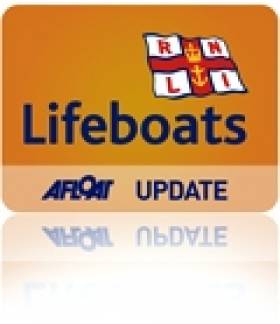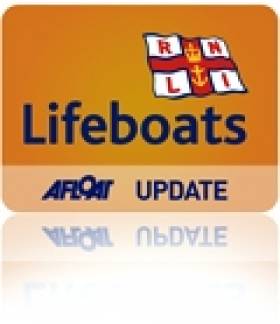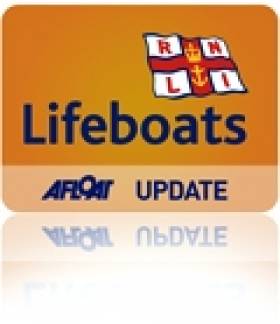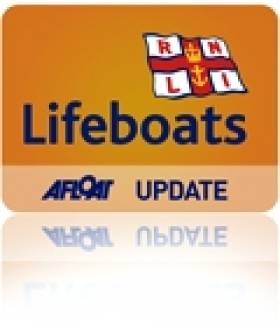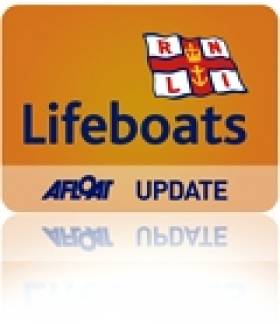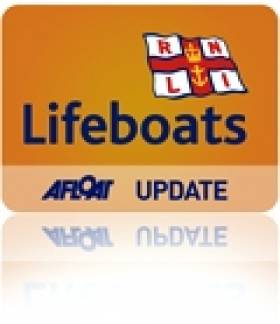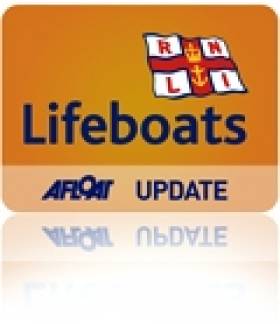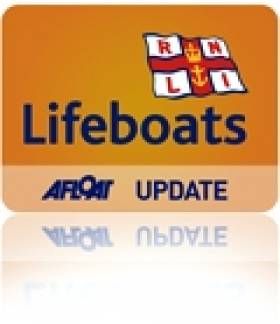Displaying items by tag: RNLI
Wicklow Lifeboat Rescues Jetskier After Engine Cuts Out
#RNLI - Wicklow RNLI's inshore lifeboat launched at 2.25pm yesterday afternoon (Friday 3 July) to assist a jetskier north of the harbour.
The jetskier had set off from Wicklow and was about a half mile offshore when the engine cut out, leaving him adrift and unable to get ashore.
Within minutes of launching, the lifeboat reached the casualty, who was then taken on board with his jetski in tow back to Wicklow Harbour.
The inshore crew on this callout were helm Dave O'Leary, Lisa O'Leary and Carol Flahive.
#RNLI - The RNLI will have a fully operational lifeboat station in Belfast City from 9am tomorrow 2 July right through to Sunday evening 5 July for the Tall Ships Races.
With up to 750,000 visitors expected in Belfast over the next four days, a number of volunteers from Bangor and Red Bay lifeboat stations will be on call to provide a 24-hour search and rescue service during the event.
The crew will operate from a temporary lifeboat station located in Belfast Harbour Marina and will respond to any emergency on Belfast Lough using an Atlantic 85 relief lifeboat.
During the Tall Ships Parade on Sunday, both the Atlantic 85 lifeboat and an all-weather Trent class lifeboat crewed by Donaghadee RNLI will be operational on Belfast Lough for search and rescue capabilities.
Speaking ahead of the Tall Ships Races, RNLI divisional operations manager Darren Byers said: "For the duration of the weekend and specifically to accommodate the large numbers expected to descend on Belfast to watch the Tall Ships spectacle, the RNLI will be fully operational at the heart of where all the activities will be taking place.
"Belfast RNLI will operate for four days only supported by its nearest lifeboat stations at Bangor and Larne. This means should there be an emergency during the event, we can reduce the time it takes to get on scene while maintaining a business as usual operation at our flank lifeboat stations."
The RNLI will have a significant presence on site throughout the weekend and has been honoured to be chosen by Tall Ships Belfast as one of five key maritime charities to benefit.
As well as a fully operational lifeboat station, the RNLI will have an all-weather Trent class lifeboat afloat which can be viewed from the quayside at Belfast Harbour Marina. Volunteer lifeboat crew will be on hand to answer any questions and to demonstrate how they use the lifeboat for search and rescue.
RNLI lifeguards who patrol 10 beaches in Northern Ireland during the summer season will also be displaying the rescue water craft and lifesaving kit they use.
Visitors to the RNLI areas can also take part in the ‘Get Your Kit on Challenge’. This is a timed challenge that pits members of the public against the clock to see how long it takes them to put on an inshore lifeboat crew member’s full kit: dry suit with yellow wellies, lifejacket with crotch straps and helmet. The lifeboat crew do this in seconds as they race to launch the lifeboat on a callout.
RNLI community fundraising manager Nicola Kelly is looking forward to the event. "The RNLI is hosting a variety of engaging activities at Tall Ships Belfast and we are honoured to have been selected as one of the official charities to benefit," she said.
"We are looking forward to welcoming visitors to the RNLI areas and hope that in doing so we can provide an entertaining, informative and interesting aspect to the full programme being provided.
"As well as saving lives at sea and on inland waters, the RNLI also provides education along with sea safety advice and demonstrations and we hope spectators can sample a flavour of that this weekend."
#RNLI - Skerries RNLI brought four people to safety on Sunday afternoon (28 June) after their racing yacht began taking on water after striking rocks near one of the islands off Skerries.
Volunteers launched their Atlantic 85 inshore lifeboat Louis Simson shortly after 4pm when reports were received by Dublin Coast Guard that a yacht had struck rocks near Colt Island.
The lifeboat, with Philip Ferguson at the helm and crewed by Eoin Grimes, Simon Shiels and Emma Wilson, made its way directly to the area reported, where the casualty vessel was quickly located.
Having freed themselves from the rocks, the yacht and its crew were making their way towards Skerries Harbour, though water was leaking into the yacht through damage to the hull.
The lifeboat was positioned alongside and a crew member boarded, bringing the salvage pump carried aboard the lifeboat.The yacht was then taken under tow and brought to the safety of Skerries Harbour, where several more volunteer crew joined the others and assisted in getting the yacht on to a trailer and taken out of the water.
Speaking after the callout, Skerries RNLI volunteer lifeboat press officer Gerry Canning said: "The RNLI spends a lot of time and effort making sure that our volunteers have exactly the equipment they need to cater for any kind of emergency.
"In emergencies such as this, the salvage pump can be invaluable."
Howth RNLI Lifeboat Rescues Kayakers in Difficulties
#rnli – Howth RNLI inshore lifeboat launched at 4.40pm Monday 29th June to reports of four men in two kayaks in difficulties one mile north of Howth harbour with one of the men in need of medical assistance.
The pagers sounded to launch the inshore lifeboat on Monday 29th June to come to the assistance of reports of 4 men in 2 kayaks with one of the men in need of medical assistance.
The casualty had been kayaking with his 3 friends when one of the kayaks overturned throwing the occupants into the water. The man was not wearing a wetsuit or a buoyancy aid and was suffering from the onset of hypothermia.
The lifeboat located the casualties within 4 minutes of launching and took all 4 men aboard the lifeboat with the kayaks in tow and treated the casualty for hypothermia at the scene.
Volunteer lifeboat helm; Ian Martin said "The casualty was in this instance extremely lucky as without a proper wetsuit his core body temperature was dropping very fast and this could have been very serious. We urge all kayakers to have the proper clothing, wetsuits and lifejackets before heading out to sea"
RNLI Honours Contribution of Irish Volunteers at the Annual Presentation of Awards in Dublin
#rnli – The RNLI held its Annual Presentation of Awards at the Guinness Storehouse on Saturday where the charity presented 55 awards to volunteers, groups and businesses from across the country that have made a significant contribution to the RNLI in Ireland through their commitment, dedication and support.
Guest of honour at the ceremony was Leesa Harwood, RNLI Director of Community Lifesaving and Fundraising. Also present was David Delamer, Chairperson of the RNLI Council in Ireland, who welcomed the volunteers and supporters to the ceremony. RNLI Irish Council members Terence Johnson and Peter Killen were also in attendance and the citations for each awardee were read by Emma Gibson RNLI Area Manager and Owen Medland RNLI Divisional Operations Manager for Ireland central.
In her address to the guests Ms Harwood said that the awards were a 'celebration of the difference that the volunteers and supporters had all made to the lives of others.'
'Our charity made an extraordinary difference in 2014. I am very proud to tell you that last year, together, we saved 460 lives. Today we celebrate not just those whose lives we saved, but the people who made this incredible number possible. We celebrate remarkable fundraising feats and decades of lifesaving service given by volunteers. And we say thank you.'
Turning to the RNLI's work in Ireland she continued, 'In Ireland we completed a new trial station at Union Hall in county Cork, and the facilities needed to trial an all-weather lifeboat at Clifden, county Galway. With the backing of their local communities, these vital projects mean we can respond to the changing demands of search and rescue on the water, test new ideas and ultimately save more lives around our coastline.'
Awardees were present from across Ireland representing lifeboat stations and branches in Dublin, Wicklow, Galway, Cork, Waterford, Mayo, Kildare and Wexford.
One of the biggest awards of the evening went to the people of Kinvara who took home the Group Supporter Award. A short film was screened showing the incredible support the community gives to the RNLI. The small Galway village came together in 2006 to raise funds for Galway lifeboat station and since then over €100,000 has been raised with every member of the community getting involved.
The highest award to be presented to an RNLI volunteer during the evening was a Bar to Gold Badge, which was received by Ms Patricia Foot. Patricia from Mallow was recognised for her role in fundraising for the RNLI for over half a century.
The recipient of the Branch Support Award went to Dungarvan RNLI. The hard working branch holds a number of successful events throughout the year both alone and in partnership with other stations and groups including the Dungarvan swim and the RNLI Reindeer Run in Fota Park.
Further to these awards ten Gold Badges, twelve Silver Badges and fourteen Bronze Badges were presented to volunteers along with a number of Inscribed Statuettes and Supporter Awards.

Ms Melanie McCaughey received a Supporter Award. Melanie from Howth completed the Paris to Nice cycle in 2014 which consisted of 700km over six days. To date she has raised €10,000 for Howth lifeboat station.
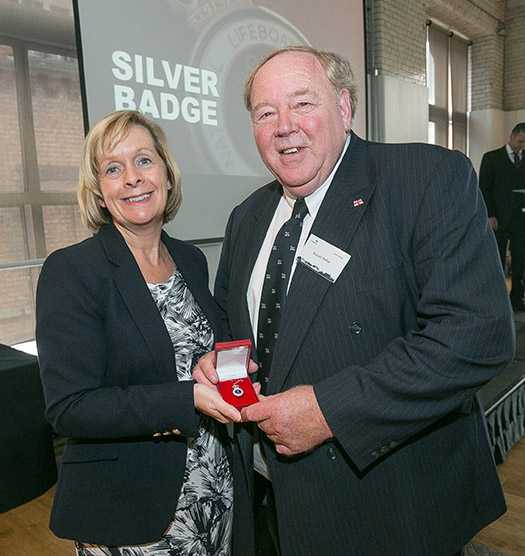
Mr Russell Rafter from Howth Lifeboat Management Group received a Silver Badge. Russell helps to cement the link between the fundraising and operations aspects of Howth RNLI in his role as Chairman of the Lifeboat Management Group. He supports the Lifeboat Operations Manager in the running of the station and also helps in fundraising by collecting on their annual flag day in the Howth area. He is an extremely active Chairman.
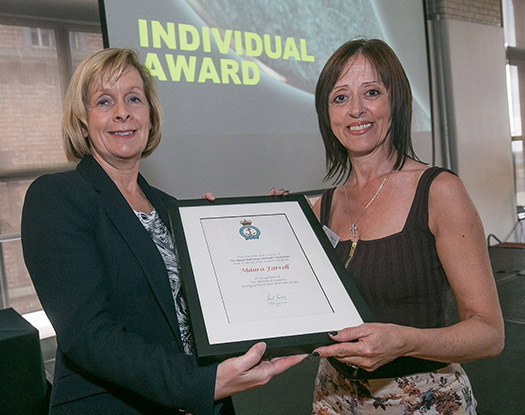
Ms Maura Farrell received a Scroll of Thanks. Maura along with her small committee organises the very successful ladies lunch in Howth which is one of the highlights of the fundraising calendar. The lunch raises in excess of €10,000 annually. Maura, whose father was the Howth Coxswain, together with family and friends are great supporters of the RNLI.
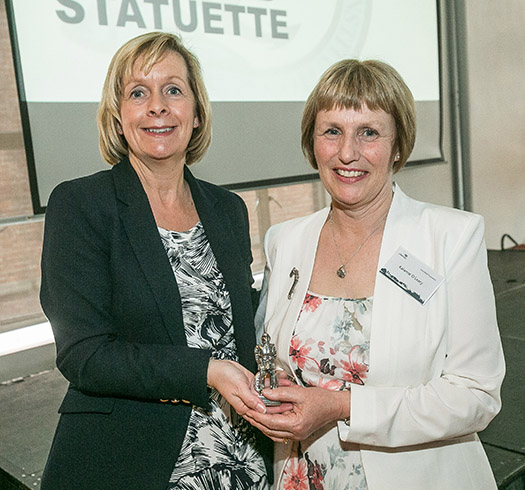
Ms Kalanne O'Leary from Skerries Station Branch received an Inscribed Statuette. Kalanne is a busy solicitor but when it comes to Skerries lifeboat she is never too busy to support in her role as Deputy Launching Authority. She supports the Operations team in all their duties.
#RNLI - Ireland's second busiest coastal lifeboat station is still without a pontoon for the safe boarding and alighting of crew and casualties, as the Sunday Independent reports.
Dun Laoghaire RNLI still uses a motor tender to transfer between the lifeboat station next to the National Yacht Club and its all-weather lifeboat anchored in the harbour.
This has proved to be a safety issue in the past, with one crew member breaking an arm while boarding the lifeboat in rough weather four years ago.
Lifeboat volunteers are also forced to use the NYC's pontoon when bringing casualties ashore, which can be problematic when its berths are full such as in the summer season.
The newspaper highlights the projected €200,000 cost of funding a dedicated launch pontoon for the lifeboat station compared to the multimillion investments around it as part of the Dun Laoghaire Harbour Masterplan, including an urban beach and a proposed new cruise liner berth.
The Sunday Independent has more on the story HERE.
Union Hall Lifeboat Rescues Five From French Yacht
#RNLI - Union Hall RNLI rescued five men after their yacht was in danger of hitting rocks off the coast of West Cork on Friday evening (26 June).
The volunteer lifeboat crew was alerted shortly after 5pm following a report from the Irish Coast Guard that a 54ft French yacht, with five men onboard, was dragging an anchor on a lee shore in the inner harbour in Glandore village.
The inshore lifeboat, helmed by Stephen Hurley and with crew members Johnny McKenna and Sean McCarthy, launched at 5.15pm and was on scene minutes later. Weather conditions at the time were described as good with a Force 4-5 westerly wind blowing.
Once on scene, the lifeboat crew observed that the vessel was in danger of hitting rocks after its propeller had got tangled in a rope. The yacht’s crew had put out an anchor but it then started to drag on a lee shore.
Having assessed the situation, one lifeboat crew member went aboard the yacht before a towline was quickly established to divert the vessel from hitting the rocks.
The lifeboat crew then proceeded to bring the vessel and the five men onboard safely back to Union Hall.
Speaking following the callout, Union Hall RNLI deputy launching authority Jim Moloney said: "The quick response of the lifeboat crew prevented a more serious situation developing this evening and I would like to commend our volunteers for using their skills and training to bring the yacht out of danger."
#RNLI - Rosslare Harbour RNLI assisted six people in the early hours of this morning (Friday 26 June) after their yacht got into difficulty off the Wexford coast.
Volunteers were alerted shortly before 2.30am following a report from the Irish Coast Guard that a 14m yacht with six people onboard was experiencing difficulties 12 miles south east of Rosslare Harbour.
The all-weather lifeboat under coxswain Keith Miller launched at 2.55am and made its way to the scene. Weather conditions at the time were described as good with some light rain and a south east Force 4 wind blowing. Visibility was fair.
Arriving on scene at approximately 3.30am, the lifeboat crew observed that no one was in any immediate danger. The yacht, which was on passage from Poland and making its way to Dublin, had got entangled in lobster pots.
Having assessed the situation, two crew from Rosslare Harbour RNLI proceeded to launch the small inshore Y boat from the all-weather lifeboat so that they could get as close as possible to the yacht.
A towline was established and the lifeboat began to gently pull until the rope was untangled and the yacht was freed. The lifeboat stood by for 15 minutes before the yacht resumed normal passage.
Speaking following the callout, Rosslare Harbour RNLI lifeboat press officer Jamie Ryan said: "The crew of the yacht did the right thing this morning and raised the alarm when they got into difficultly.
"It was an early call out for our volunteers but they were delighted to be able to assist and ensure the six crew members on the yacht could resume their passage to Dublin safely."
RNLI Lifeguards Deal With First Major First Aid Incident Ahead Of Summer Season In Northern Ireland
#WaterSafety - RNLI lifeguards commenced full-time summer patrol on 10 beaches in Northern Ireland at the weekend.
Following weeks of intensive training in preparation for the new season, the lifeguards will be keeping visitors safe on seven beaches along the Causeway Coast and three in Co Down.
The beaches include Benone, Downhill, Castlerock, Portstewart Strand, Portrush West, Portrush East, Whiterocks, Tyrella, Murlough and Cranfield.
Five of the busier beaches had lifeguard cover during the Easter period which was followed by a weekend patrol on six beaches throughout April, May and June.
During weekend patrol on Sunday 14 June, RNLI lifeguards on Portstewart Strand dealt with their first major first aid incident of the summer.
At around 4.30pm, lifeguard Mairead McKeague was on duty at the water’s edge and patrolling the area between the red and yellow flags when she spotted a teenage boy at the east of the beach who had slipped on rocks and hit his head.
McKeague alerted senior lifeguard Damian McCauley and lifeguard Clara Doran, who responded immediately while she maintained patrol of the beach.
Lifeguard James Shannon, meanwhile, acted as the communications liaison between the RNLI and their colleagues in the coastguard and Northern Ireland Ambulance Service who also responded.
On scene within five minutes, McCauley and Doran proceeded to carry out first aid and treat the casualty for a head wound. They were joined five minutes later by a NIAS Rapid Response Paramedic and the Coleraine Coastguard Rescue Team, who proceeded to transport the casualty to their vehicle.
Speaking following the incident, RNLI lifeguard supervisor Tim Doran said: "Our lifeguards worked well together, spotting the incident quickly, communicating with each other and reacting swiftly to administer first aid to the casualty.
"They used their lifeguard training and skills to good effect with this incident serving as an example of the vigilant work our lifeguards do in responding to events that happen on the beach as well as those that occur in the water."
From Saturday 20 June, the RNLI took up full-time daily duty on all 10 beaches continuing to Sunday 6 September, when weekend duty will then resume on selected beaches throughout September.
Lifeguards will be on the beach daily between 11am and 7pm on the Causeway Coast and between 10am and 6pm in Co Down.
Ahead of the new season, the RNLI has reminded visitors to the beach to ask the lifeguards for water safety advice, and to call on a lifeguard if they see anyone in difficulty.
RNLI lifeguard manager Mike Grocott also encouraged visitors to bear in mind some key safety messages.
"The RNLI’s advice for anyone planning a trip to the beach is to check weather and tide times before you go and if planning to go into the water, swim at a lifeguarded beach, between the red and yellow flags.
"Avoid using inflatables in strong winds or rough seas. If you get into trouble, stick your hand in the air and shout for help and if you see someone else in trouble, tell a lifeguard. If you can’t see a lifeguard, call 909 or 112 and ask for the coastguard."
Throughout the summer, the lifeguards will deal with a range of incidents.
"While the same safety advice applies to all our beaches, we do tend to see patterns of activity that are more specific to some beaches than others," said Grocott.
"Whiterocks, for example, is most affected by last winter’s storm damage and there is a lot of coastal erosion there. It is also a beach known for its waves and swells so it is popular with surfers and body boarders.
"Benone, Portstewart and Portrush East, meanwhile, are large beaches which we know will attract a lot of people throughout the summer. We can also expect to be exceptionally busy on vank holiday weekends, during the fortnight holiday period in July and if and when the weather peaks.
"Having a good knowledge of the profile of our beaches and the types of activities that are popular on each of them helps to guide how we carry out our lifeguard training before the season begins so our lifeguards can be prepared for all the incidents they will encounter."
Wicklow Lifeboats Launch To Report Of Floating Object
#RNLI - Both Wicklow RNLI lifeboats launched yesterday afternoon (Saturday 20 June) at 3.10pm to investigate a report of an object floating in the sea off the beach at Brittas Bay.
A vigilant lifeguard on duty at Brittas Bay contacted the Irish Coast Guard to report a white object in the water about two miles off the popular tourist beach.
Both lifeboats were on scene 20 minutes after launching, and they conducted an extensive search from Mizzen Head back towards Wicklow Head.
Conditions in the area were good, with a slight sea state and wind westerly force two. Visibility in the search area was good.
During the search the lifeboat volunteers made contact with some boats in the area but none required any assistance.
Following an extensive search of the area and no boat found to be in difficulty, the coastguard stood down both lifeboats at 4.05pm, and they were back in their station by 4.30pm.
The crew on the all-weather lifeboat were coxswain Ciaran Doyle, mechanic Connie O'Gara, John Vize and David Collard. The inshore crew were helm Graham Fitzgerald, Peter McCann and Matt Doyle.




























